RAS Bicentenary Appeal: Digitization Sponsorship
Over the past several years, the Society has digitized some of the most important parts of its collection, and has made digital facsimiles of manuscripts, archives, and artworks freely available via the RAS Digital Library (https://royalasiaticcollections.org/). This has been possible thanks to the support of a wide range of organizations and individuals, whose generosity has helped us unlock parts of the collection for a global audience.
As the Society looks to its bicentenary year in 2023 and beyond, staff and trustees have been thinking about ways to build upon previous achievements in order to enhance the Society’s charitable offering in the years ahead. One key area for future growth is the further development of our digital collections: making more of our library and archive available for scholars and the general public will help foster new research and wider public interest in the histories and cultures of Asia. To that end, we would like to invite sponsorship from our members and supporters to help digitize some key items from the collection. Each has been identified by leading experts as a key candidate for digitization due to their intrinsic interest and/or their potential contribution to wider scholarship. All items will be made available via our Digital Library as soon as they have been digitized.
The Society welcomes any enquiries about digitization, including about items not on this list. For further information, or if you have any questions, please email Edward Weech via library@royalasiaticsociety.org.
Please note that the estimated costs attached to each item are for guidance only. While every effort has been made to ensure their accuracy, final costs may vary according to market conditions at the time we place an order. These will be confirmed and agreed with the sponsor in advance before any work is undertaken.
Maxwell Malay 2, Tuhfat al-Nafis, 214 folios. Estimated cost £750-£850
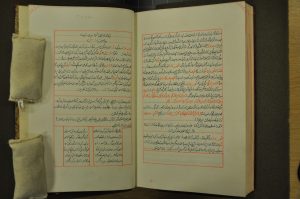
This important historical work was written in Jawi by Raja Ali Haji around AD 1866-70. It covers the history of several Malay states down to modern times, including the history of the Singapore and Malacca rulers and the founding of Johore. According to a pencilled note on the flyleaf, this manuscript copy was begun by Raja Haji Ahamad (alias Ungku Haji Tua) of Riau, son of Raja Haji, and completed by his son. It was copied for Sir William Maxwell (then British Resident of Selangor) in AD 1890. It comprises 214 folios, is written on European paper, and measures 33 x 20 cm. It was part of the Maxwell bequest to the RAS in 1898. Many of the Society’s Malay manuscripts have been digitized, and adding this volume to the online collection would further enhance its usefulness for scholars working in the Malay world and internationally. (For more information on this manuscript, see ‘A Malay history of Riau and Johore’, by R. O. Winstedt, JMBRAS 1932 (2), pp. 1-320; Ricklefs, Voorhoeve, and Gallop, Indonesian Manuscripts in Great Britain (EfEO: Jakarta, 2014), p. 143).
Turkish 47, Kulliyat of Nava’i, 640 folios. Estimated cost £2000-£2200
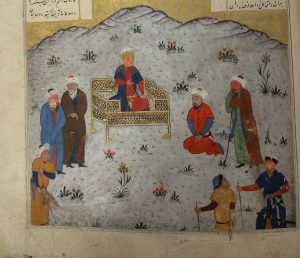
One of the most frequently consulted manuscripts in our Turkish collection, this is an early copy of the Kulliyat (collected poems) of the poet Ali-Shir Nava’i (AD 1441-1501), considered the greatest representative of Chagatai literature. The manuscript itself dates from the AD C16th and contains five miniature paintings. The miniatures depict scenes from the stories of Alexander the Great, Farhad and Shirin, Hayretu’l-Ebrar, and Layla and Majnun. These all pertain to Nava’i’s Khamsa (five poems), written between 1483 and 1485. Nava’i was the first person to write a Khamsa in Turkish. The manuscript is written in Nasta’liq script and measures 34 x 23 cm. This manuscript was donated to the Society by R. S. Greenshields in 1934. For more information about this manuscript and its miniature paintings, see the blog post at https://royalasiaticsociety.org/reading-manuscript-paintings-in-the-kulliyat-of-navai-and-ras-agm-2022/.
Persian 251, Bustan of Sa’di, 149 folios. Estimated cost £600-£700
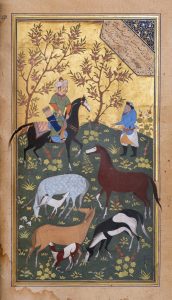
The Bustan was the first major work by the Persian poet Sa’di (AD 1210-1291/2), and includes accounts of the author’s travels and analysis of human psychology. This high-quality Bustan manuscript was beautifully written and richly illuminated by the calligrapher Sultan Mohammed Nur in Bukhara around AD 1530. It features an elaborate red leather Indian binding with stamped decoration and central panels of green velvet. The interiors of the covers also have stamped and painted decoration, and it features an elaborately illuminated initial opening and headings in gold on panels filled with illuminated scrolls. The folios are of varied colours and the broad margins are splashed with gold. Also boasting two miniatures in the Bukhara style, it comprises 149 folios, and is written in Nasta’liq script. This manuscript was presented to the Royal Asiatic Society by Lieut. Colonel Doyle on 15th March 1834. For further information, see B. W. Robinson, Persian Paintings in the Collection of the Royal Asiatic Society (London: Royal Asiatic Society, 1998), pp. 53-55.
Persian 246, Khamsah of Nizami, 338 folios. Estimated cost £1100-£1250
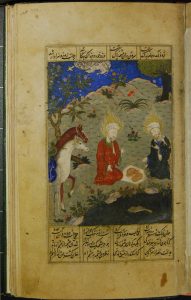
This high-quality manuscript includes the five long poems of Persian poet Nizami Ganjavi (AD 1141-1209). It contains fine illumination and 21 miniature paintings, seemingly of the Turkman school. These miniatures have proven to be particularly useful for teaching students of Persian painting. It comprises 338 folios, was made around AD 1450, and is written in Nasta’liq script. It was presented to the Royal Asiatic Society by Lieut. Colonel Doyle on 15th March 1834. For further details, see B. W. Robinson, Persian Paintings in the Collection of the Royal Asiatic Society (London: Royal Asiatic Society, 1998), pp. 8-14.
Persian 244, Shirin va Khusrau of Hatefi, 94 folios. Estimated cost £400-£450

This sumptuous manuscript contains the story of Shirin and Khusrau as told by the Persian poet Hatefi (AD 1454-1521). It was made in Khurasan around AD 1575. The manuscript features a panel of illumination above the opening of the text, smaller ones on the last two folios, and headings in white on gold. It has elaborate borders, many based on stencils, six miniatures, and one tinted drawing. It comprises 94 folios and is written in Nasta’liq script. This volume was presented to the Royal Asiatic Society by Lieut. Colonel Doyle on 15th March 1834. For more details, see B. W. Robinson, Persian Paintings in the Collection of the Royal Asiatic Society (London: Royal Asiatic Society, 1998), pp. 59-61.
Papers of Brian Houghton Hodgson, 10 archival boxes. Estimated cost £3000-£4000

Brian Houghton Hodgson (1801-94) was a pioneer naturalist and ethnologist who served as British Resident in Kathmandu, Nepal. During his two decades in Nepal he developed a deep interest in the local region and its people, natural history, religion, languages, and architecture. Hodgson became an avid student and collector of indigenous species, publishing 97 papers on the birds and mammals of Nepal. He also made a lasting contribution to the European study of Buddhism. Hodgson amassed a major collection of Buddhist Sanskrit manuscripts which he deposited in institutions across Europe, and these became a key resource for European scholars trying to understand the origins and history of Buddhism in South Asia. Hodgson’s wide interests, and influence as a collector, have led to him being dubbed the ‘father’ of Himalayan studies in Europe.
Hodgson left behind voluminous archives and other collections, which were divided between different institutions. The extensive Hodgson archive at the RAS comprises ten archive boxes, the contents focusing on his research on languages and religion, while also containing correspondence with the botanists Sir Joseph Dalton Hooker and Archibald Campbell. The archive also includes Hodgson’s ‘autograph book’, in which he saved many of his most important documents, including letters from Macaulay, Dwarkanath Tagore, Max Muller, Alexander Csoma de Koros, Eugene Burnouf, and Jung Bahadur, Maharaja of Nepal. A full catalogue of the Hodgson Collection is available at https://archiveshub.jisc.ac.uk/data/gb891-bhh. (Please note that the digitization proposal and cost estimate do not include the series of printed material contained within this archive, BHH/13 – BHH/21).
Digitizing this collection would make it much easier for scholars to investigate Hodgson’s widely distributed collections, and would serve as a major contribution to the study of the history and culture of Nepal. It would also complement the manuscripts and artworks from Hodgson’s collections which the Society has already digitized, and which can be found via our Digital Library at https://royalasiaticcollections.org/.
Tod 126, Two texts on Indian history and legends, 59 folios. Estimated cost £350-400
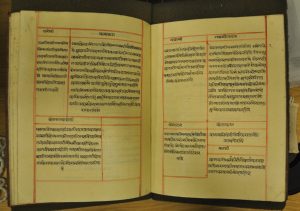
This manuscript consists of two texts bound together in one volume: Hindusthān-kī bādshāhī-kā pramāṇ vā oddhā kārkhānā-kī kitāb (tabulated sketch of administrative offices in the kingdoms of India), and Vikrama-vilāsa (tales of King Vikramāditya by Miśra Gaṅgeśa). Rima Hooja notes that these texts appear to have been copied from texts in the library of Maharaja Sawai Jai Singh – Jaipur’s original library. Part of this library was dispersed early in the 19th century during the reign of Maharaja Sawai Jagat Singh. It is therefore possible that these texts were copied from manuscripts no longer in the City Palace Library in Jaipur. The copies are dated 1815.
Tod 148, Śakunāvalī-vicāra, 40 folios. Estimated cost £300
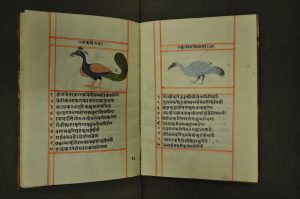
This manuscript is a work on omens to be derived from animals and birds, and includes 39 illustrated pages with finely executed coloured drawings. Rima Hooja notes that this is an uncommon work which situates its discussion of omens within an astrological context, and includes a segment on the interpretation of dreams. Its interest arises not only from its illustrations, but from its distinctive representation of folk traditions and psychological symbolism. Inscription by James Tod on flyleaf reads ‘Sookun avali or History of Omens from Library of Rawul Moolraj of Jesselmere.’ This copy was made in 1818.
